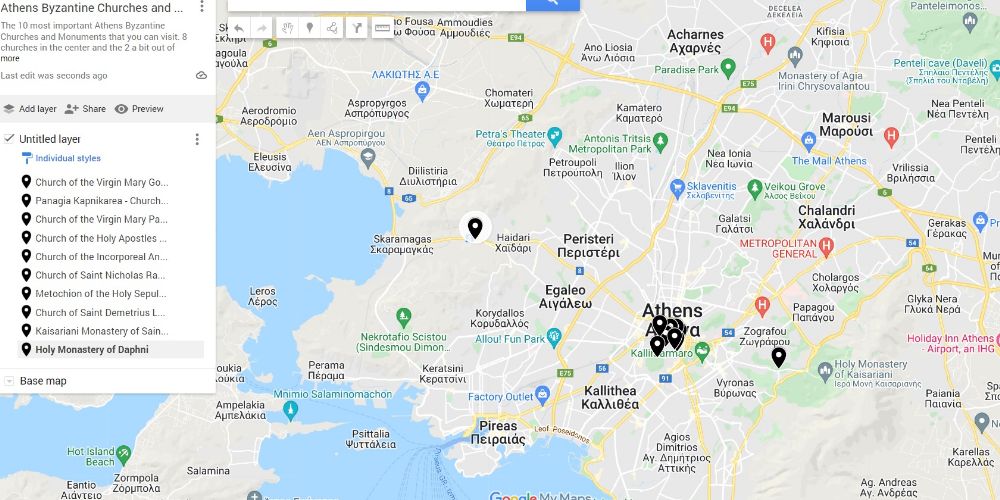I live in Athens, close to the city center, so I often find myself downtown. Until a few years ago, I hadn’t realized how many Byzantine churches and monasteries were scattered throughout the city center. For example, while shopping on Ermou Street between Zara and Bershka, you suddenly encounter an ancient church, Kapnikarea, in the middle of the pedestrian area, causing you to navigate around it to continue your shopping.
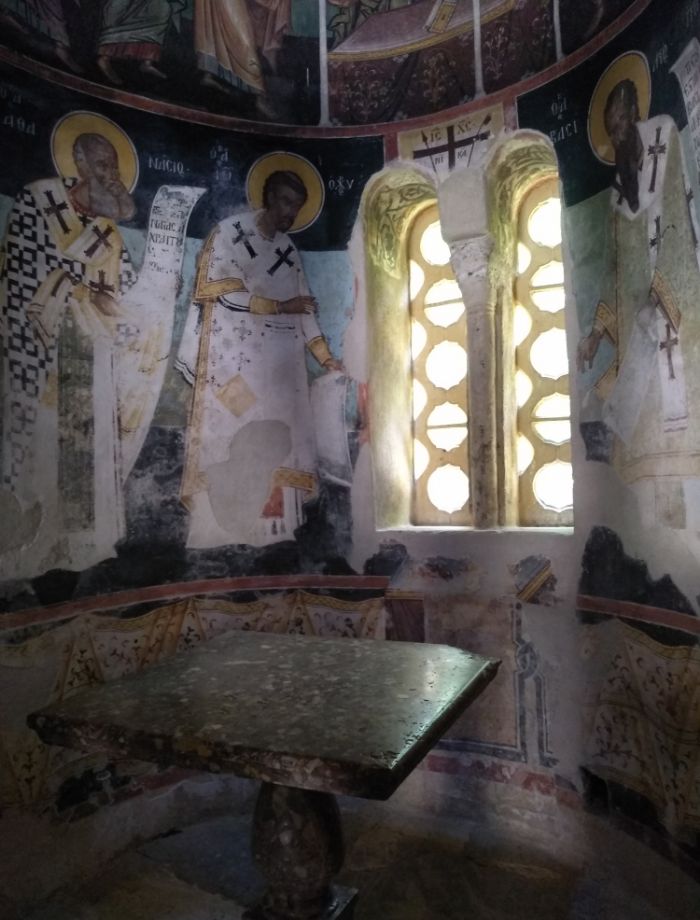
Another striking example of Byzantine Athens lies within Ancient Agora, Athens’ second most important archaeological site. Amongst ancient ruins stands the magnificent Agioi Apostoloi Solakis Byzantine church. So, without further ado, let’s discover together the Byzantine treasure of Athens!
Some of the links below are affiliate links. That means I may make a commission if you click and buy. The commission comes at no additional cost to you.
Latest Athens Video (With a Byzantine Church)
The only Byzantine monasteries that need a car as they are both a bit out of Athens’ center (20 minutes away) are the Kesariani Monastery and the UNESCO Daphni Monastery. So let me take you to the most striking Byzantine churches in Athens!
Short History of Athens Byzantine Churches
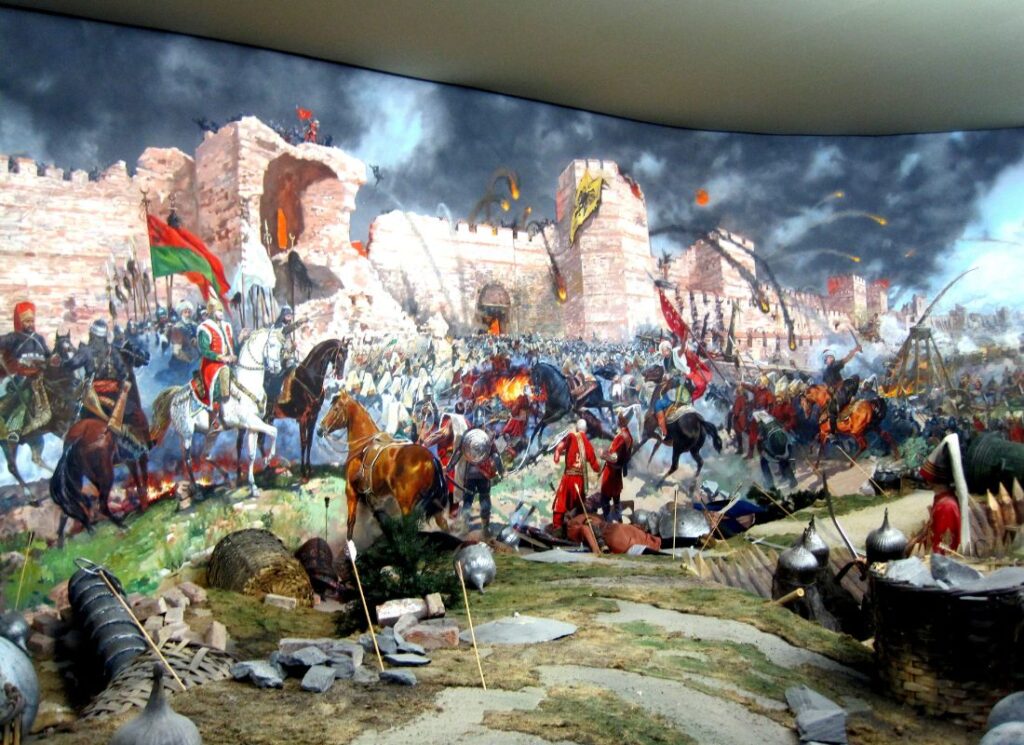
Byzantine Empire began with the inauguration of Constantinople on 11th May 330 AD and continued until its final fall of Constantinople to the Ottomans on 29th May 1453.
Ancient Athens, after the successive barbarian raids, disasters, and the Roman conquest had passed into an era of decline. From 380 CE onwards, the Byzantine Emperors issued decrees trying to eliminate the ancient Greek religion and establish the new one, Christianity.
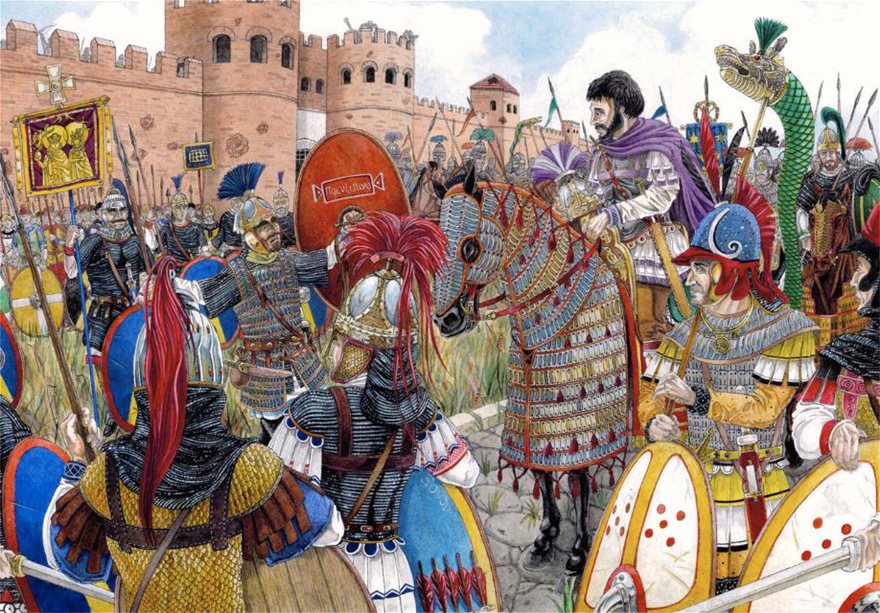
The decrees issued by Theodosius I (380-394), banned ancient worship and the Olympic Games. Theodosius II (408-450) abolished the Eleusinian cult. Later, Justinian (527-565), under the pretext of financial difficulties, closed the Plato philosophical schools of Athens.
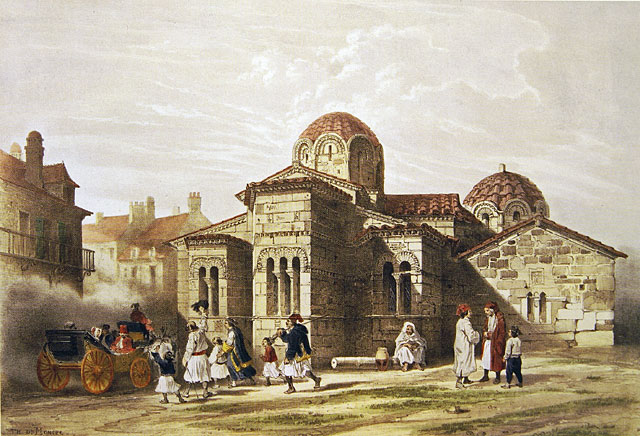
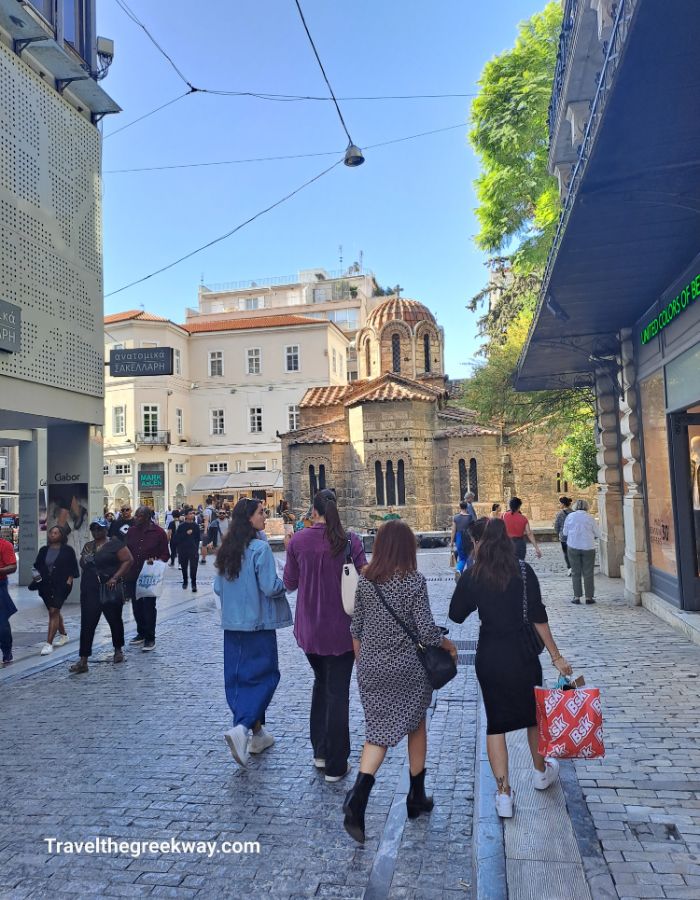
After the decree of Theodosius II, the ancient temples were hastily and destructively converted into Christian churches. The Parthenon (which means virgin in Greek) on Acropolis Hill, from the temple of the Parthenon goddess Athena, became the temple of the Parthenon Holy Mary (Panagia Athiniotissa).
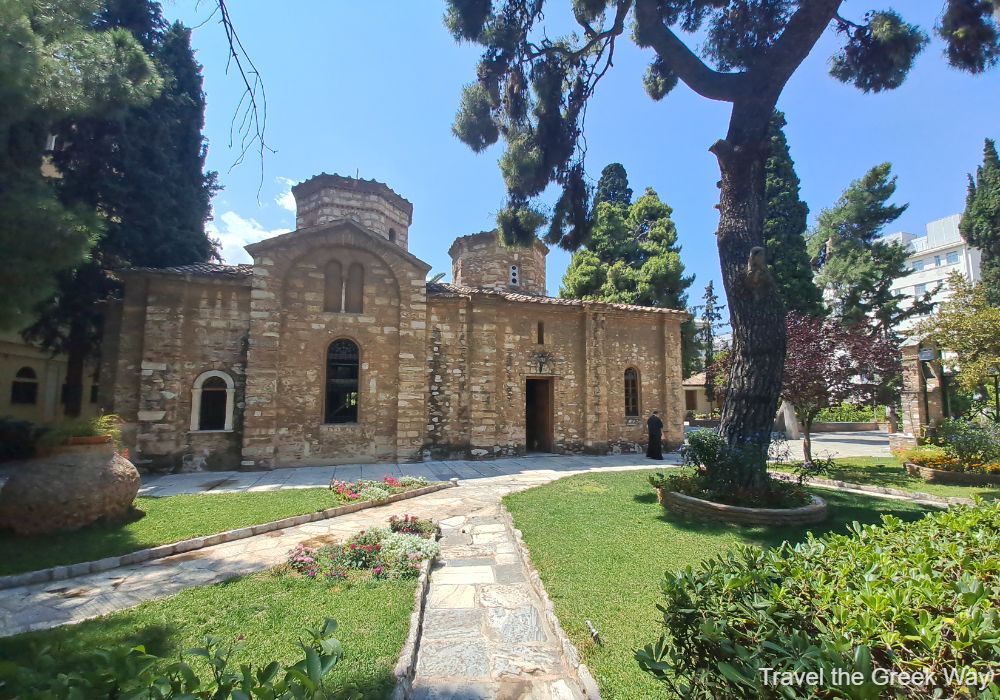
The monuments that are preserved today are a testimony to the importance of Athens and its role in the medieval empire of Byzantium, proving at the same time its timeless cultural continuity, from antiquity to the present day.
Athens Byzantine Churches Architecture
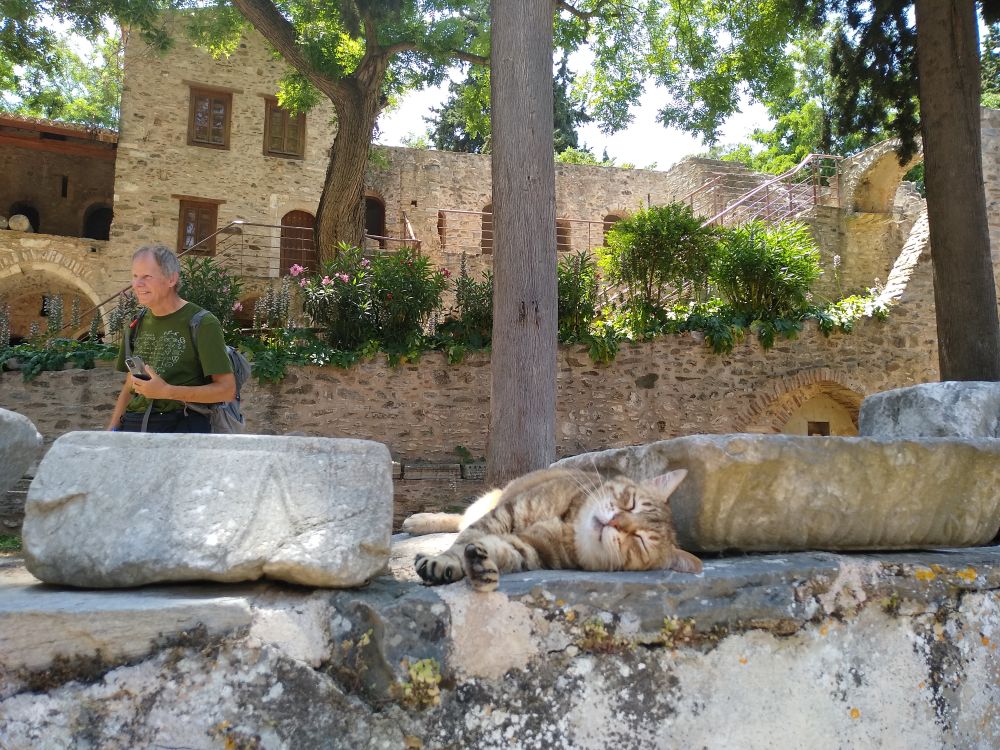
Some of the unique features of Byzantine architecture are:
- characteristic domes
- The use of brick as a building material in place of stone
- The extensive use of mosaics as a decorative element in place of sculpture
- The greater height of buildings as a result of the use of domes
- the invention of a system that allows the combination of the building use of these domes with the support of a square plane
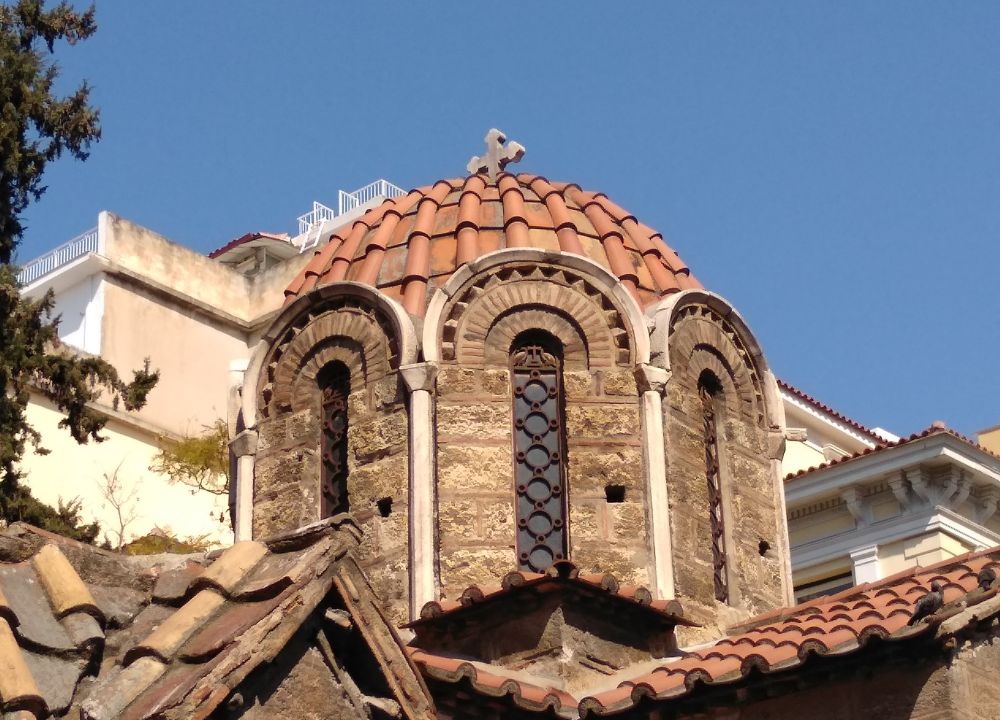
What truly distinguishes these churches as ‘Athenian’ are their unique red-tiled, eight-sided domes (Athenian Dome) that crown these holy buildings, representing the last traces of Byzantium in Athens. Up next I am going to tell you about the 10 best Athens Byzantine churches and monasteries.
1. The Church of Panagia Gorgoepikoos & Agios Eleftherios
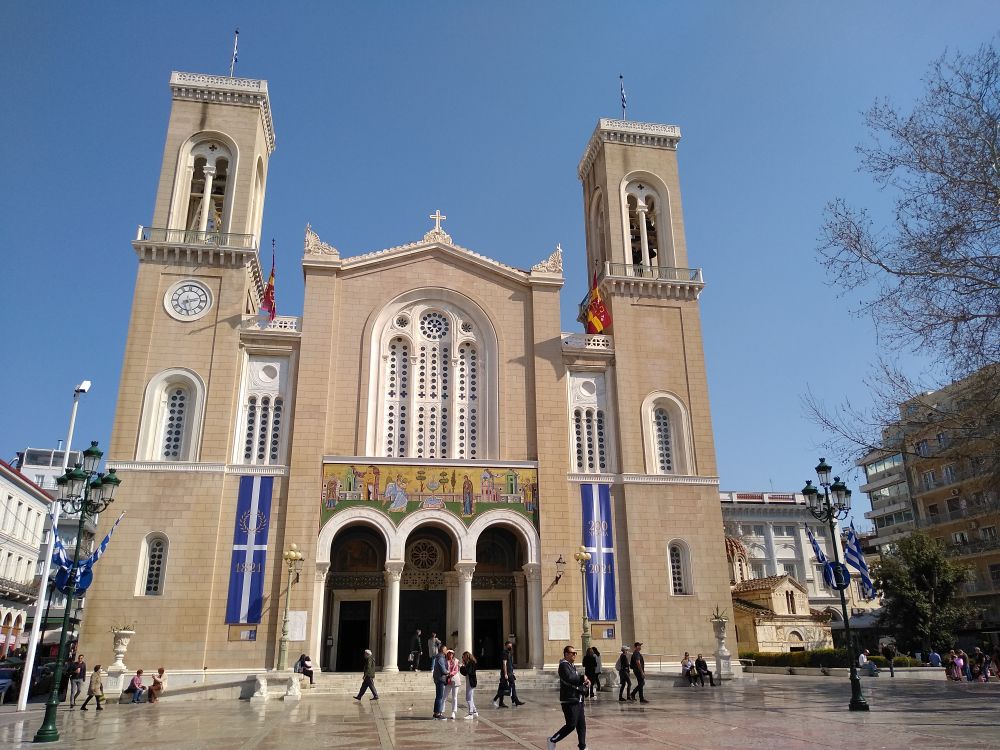
As the Metropolis of Athens dominates the square in Athens center, not everyone notices the little masterpiece of a Byzantine church on its side, built on top of an ancient temple dedicated to Eileithyia.
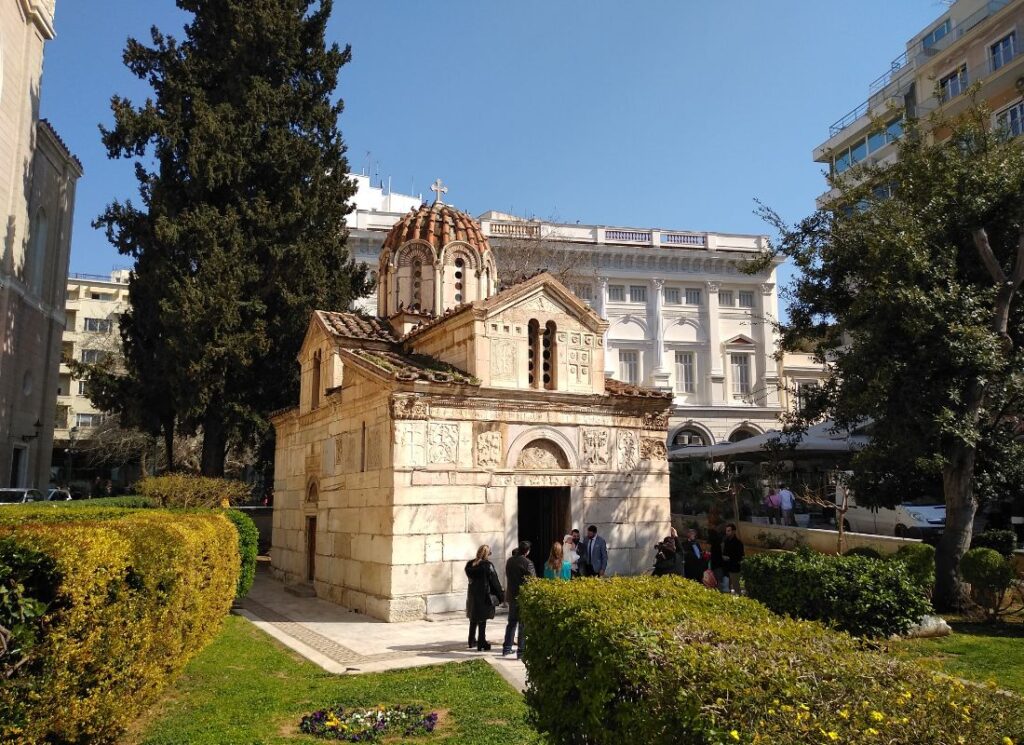
Unlike most Byzantine churches of its era (built in the 12th century), it is made of marble, unsculptured stones, and reliefs. Inside the upper part of the walls, 90 reliefs have been placed, creating a spectacular decorative effect for a Byzantine church.
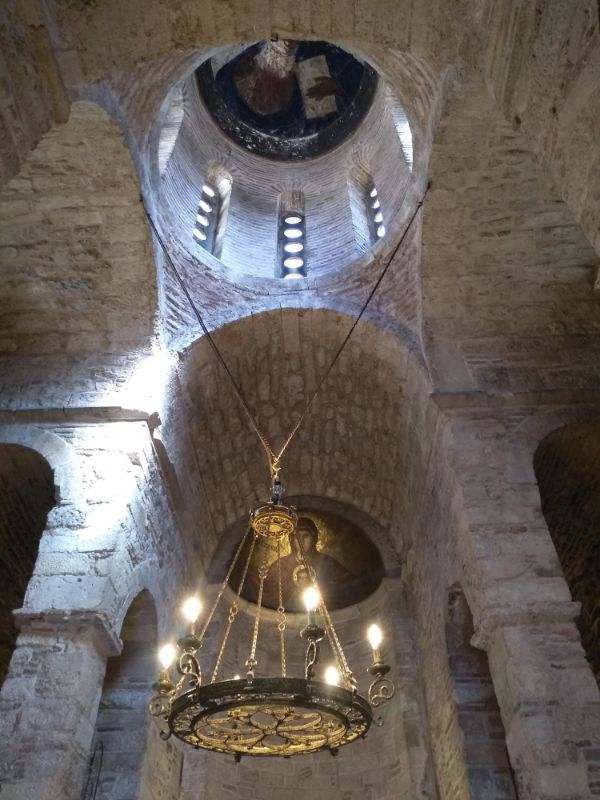
Another unique characteristic of this Byzantine Church is that it is dedicated to two saints, Panagia Gorgoepikoos and Agios Eleftherios. It is celebrated on 28 October & 15 December.
Entrance Info:
- Opening hours: 10:00 – 18:00 daily
- Entrance Fee: Free
- Dress Code: Avoid shorts, remove your hat inside the church
- No food/drinks are allowed besides water
- No photos with flash
- Lower your voice
Are you looking for a central Athens apartment for your trip? Check out Star Acropolis Apartment!
2. Panagia Kapnikarea in Ermou St
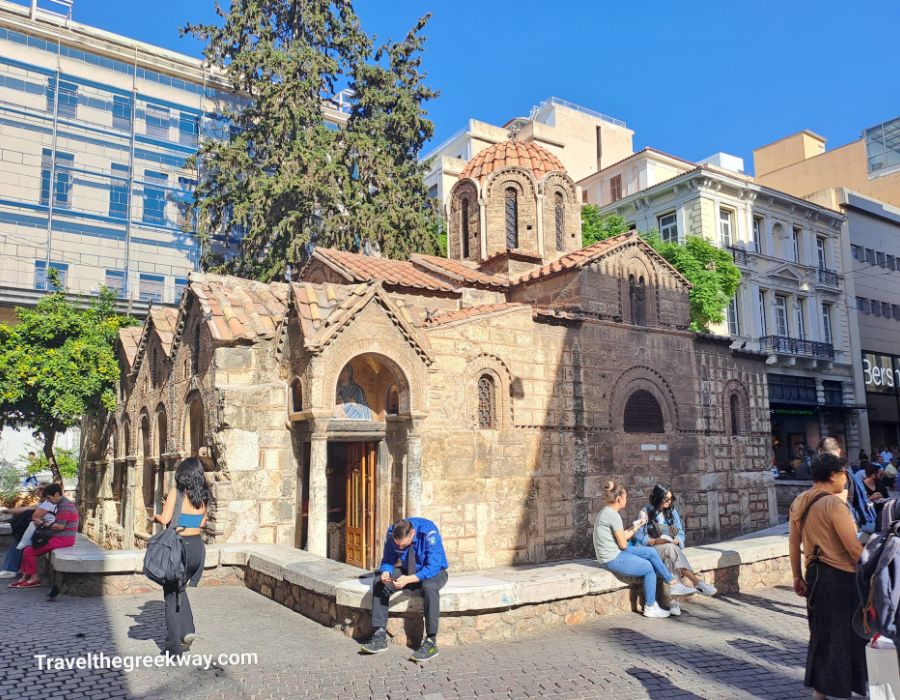
Panagia Kapnikarea Church or Holy Church of the Presentation of the Virgin Mary was built in the 11th century and today stands in the middle of the busiest shopping pedestrian street in Athens. As you can imagine it is one of the most well-known churches in Athens and a popular meeting point.
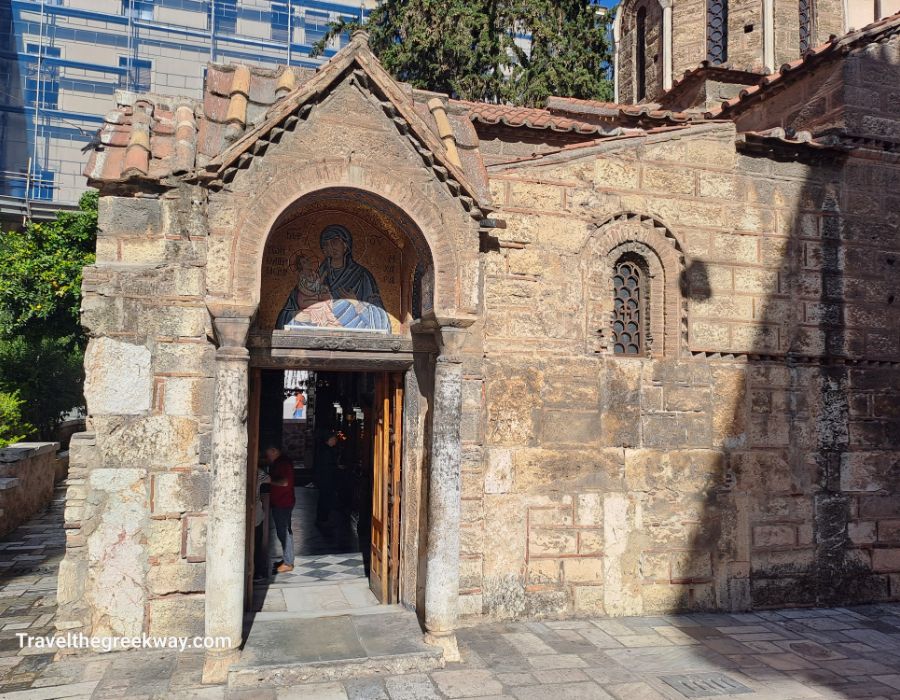
Kapnikarea has a complex cross-in-square construction with a dome that is supported by four Roman columns. The frescoes of the church belong to the modern era, from 1942, and were painted by Fotis Kontoglou and his students, a Byzantine art school. On the north of Kapnikarea Church, a chapel dedicated to St. Barbara has been attached, dating back to the late Ottoman period.
It is celebrated on 21 November.
Entrance Info:
- Opening hours: weekdays, Sat. 11:00-17:00, Sun: 07:00-13:00.
- Entrance Fee: Free
- Dress Code: Avoid shorts, remove your hat inside the church
- No food/drinks are allowed besides water
- No photos at all
- Lower your voice
3. Church Panagia Pantanassa in Monastiraki
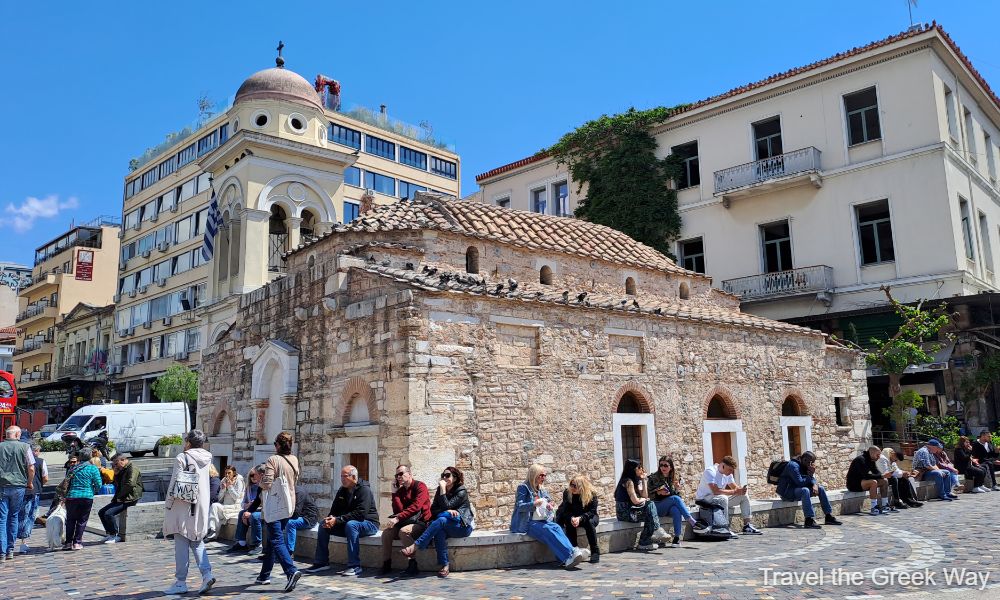
The Byzantine church of Panagia Pantanassa is located in Monastiraki Square, a very popular and lively square close to most archaeological sites of Athens.
There is some conflict as to when exactly Panagia Pantanassa was erected. The archaeologists Sotiriou and Wulff placed the construction of the Temple around the 8th century AD, which they consider to be the date of all the arched basilicas of Athens. If this is true, it makes Panagia Pantanassa the oldest church in Athens. However, Orlandos and Xygopoulos archaeologists consider that the original Church was built in the 10th century AD.
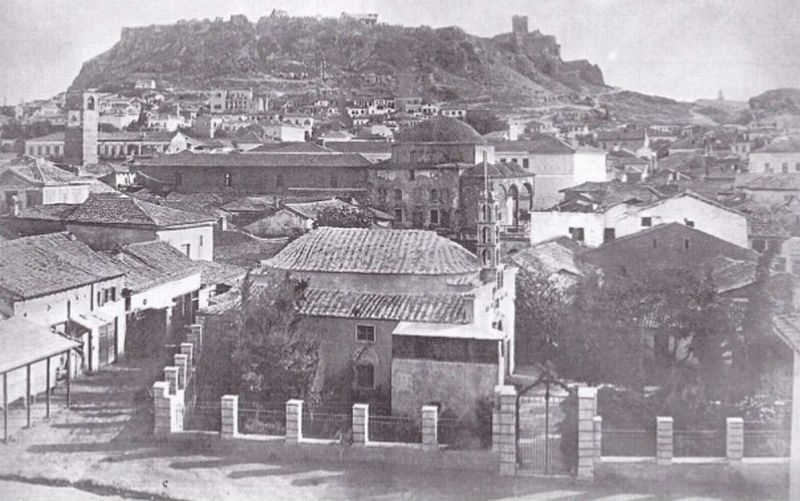
What is certain is that the church was built as the Katholikon of the Great Monastery that was occupying the whole square 1000 years ago. Its architecture is a vaulted basilica, with many alterations through the centuries. The frescoes are from the modern era.
It is celebrated on the 15th of August. The church today is a parish and is served by Fr. Gabriel Teknetzoglou. The telephone number of the church is +30 210-3213038.
Entrance Info:
- Opening hours: every day until evening
- Entrance Fee: Free
- Dress Code: Avoid shorts, remove your hat inside the church
- No food/drinks are allowed besides water
- No photos with flash
- Lower your voice
Are you a group of 10 people and are looking for a large enough central Athens accommodation? Check out Athenian Niche in Plaka Villa!
4. Agioi Apostoloi Solakis in Ancient Agora
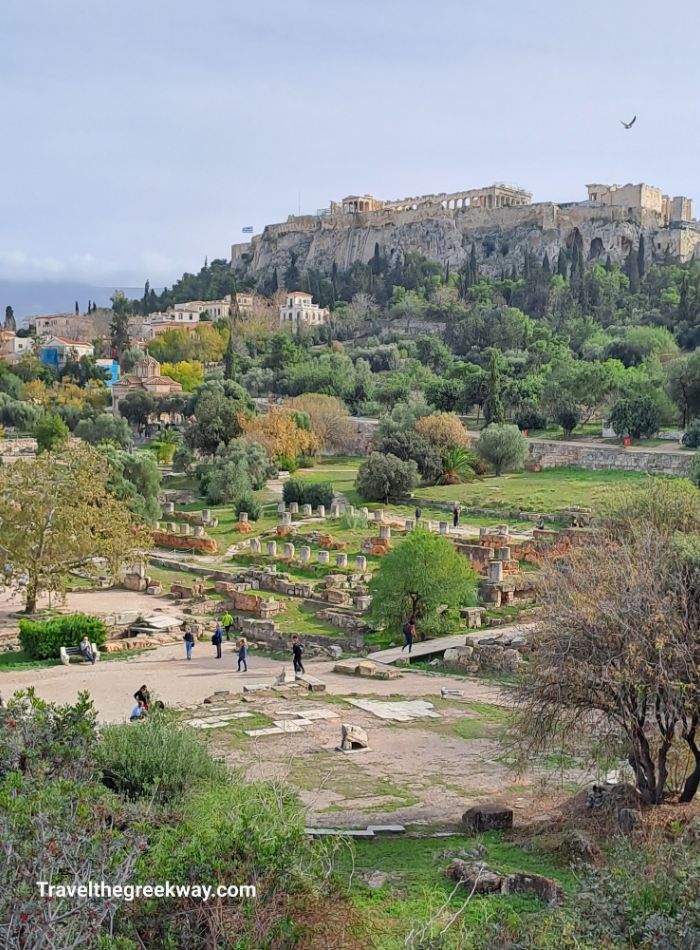
Ancient Agora is the second most important archaeological site in Athens right after the Acropolis Hill. It is my favorite site as it is a very green area and in the spring the whole place smells of chamomile and daisies. And on top of the Ancient Agora, near the Stoa of Attalos, sits the gorgeous Byzantine temple of Agioi Apostoloi Solakis.
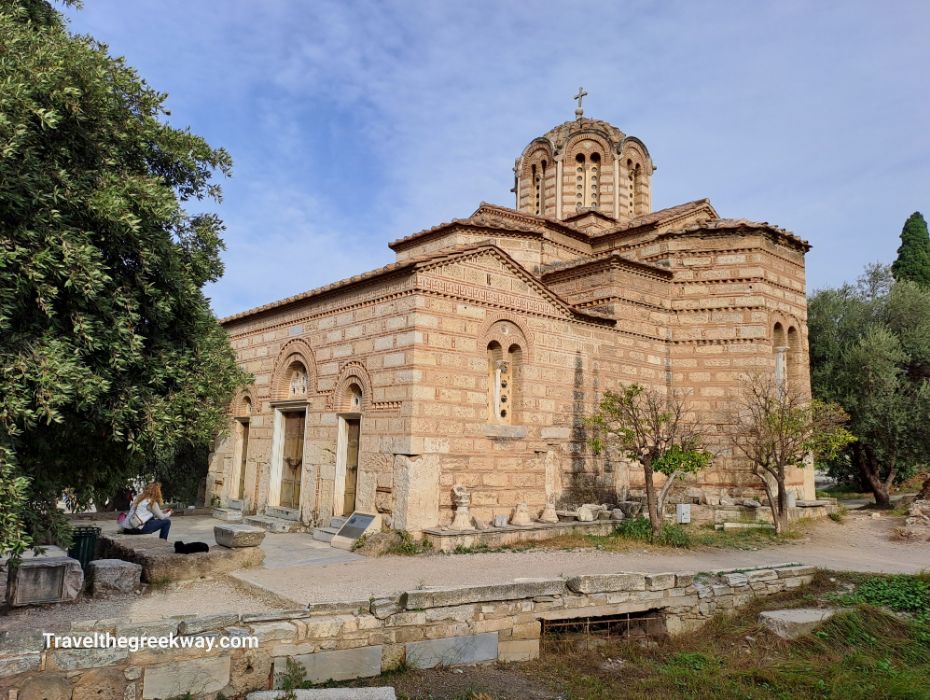
The Agioi Apostoloi Solakis Church is a magnificent Middle Byzantine ecclesiastical building. It was built in the 10th century on an ancient monument dedicated to the Nymphs. To visit it you have to pay for an entrance ticket for the Ancient Agora (€10).
It is celebrated on 30 June. Opening hours: 08:00 – 18:00 (in summer), 08:00 -17:00 (in winter).
5. Agioi Asomatoi (Incorporeal) Church in Thissio
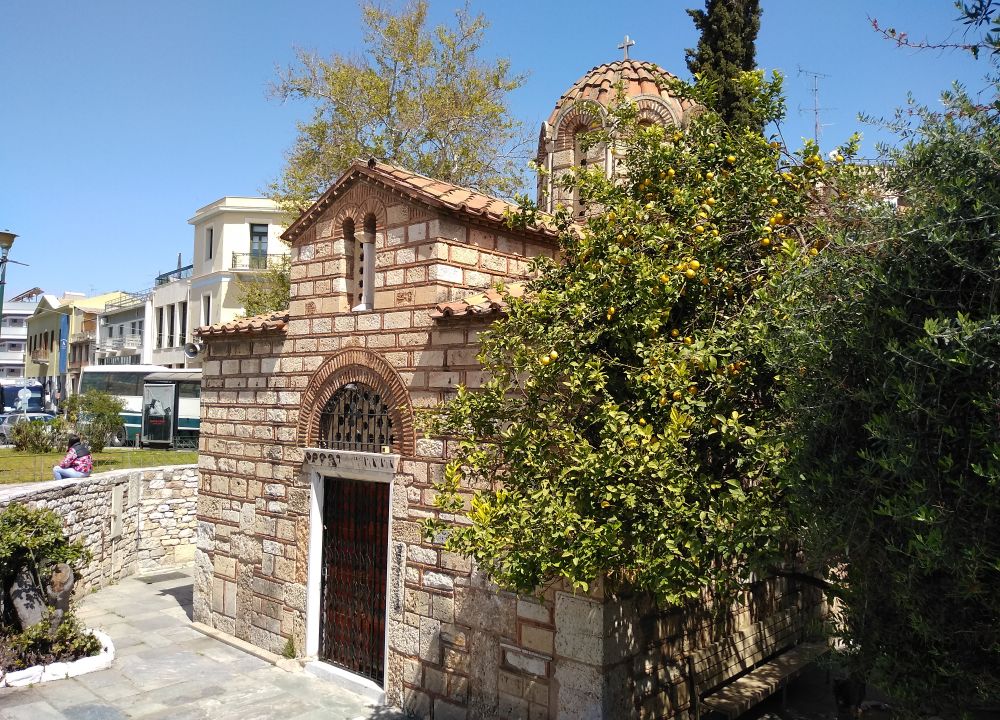
Built in the 11th century, Agioi Asomatoi’s small church is dedicated to the Incorporeal Saints or angels. The church is a typical example of the Athenian Byzantine church with a characteristic entrance decorated with marble. The horseshoe-shaped arch above the north entrance is also of Islamic inspiration.
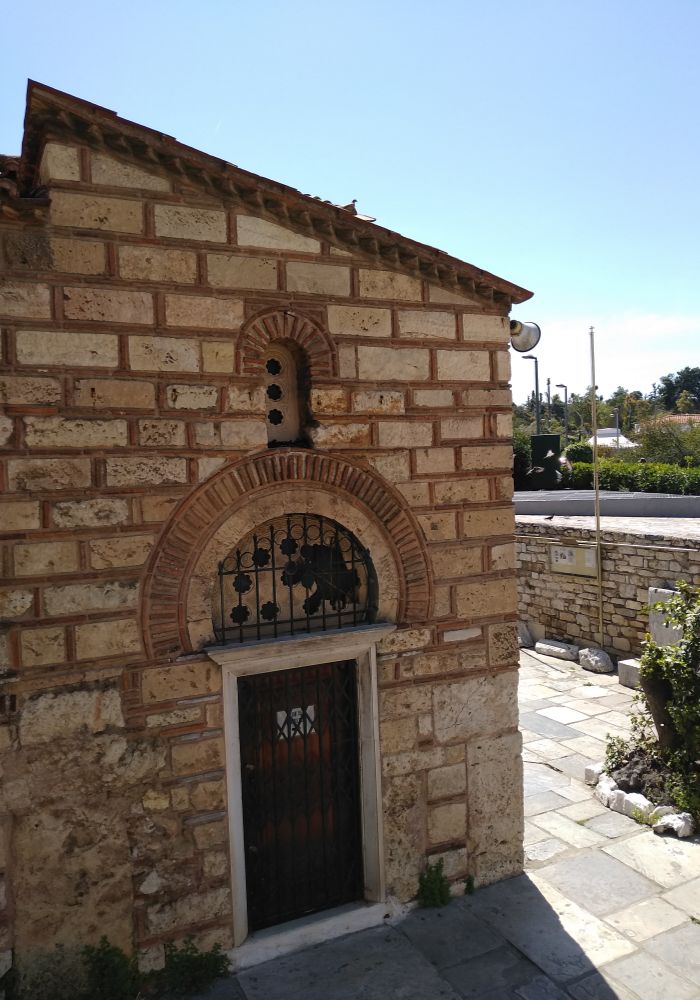
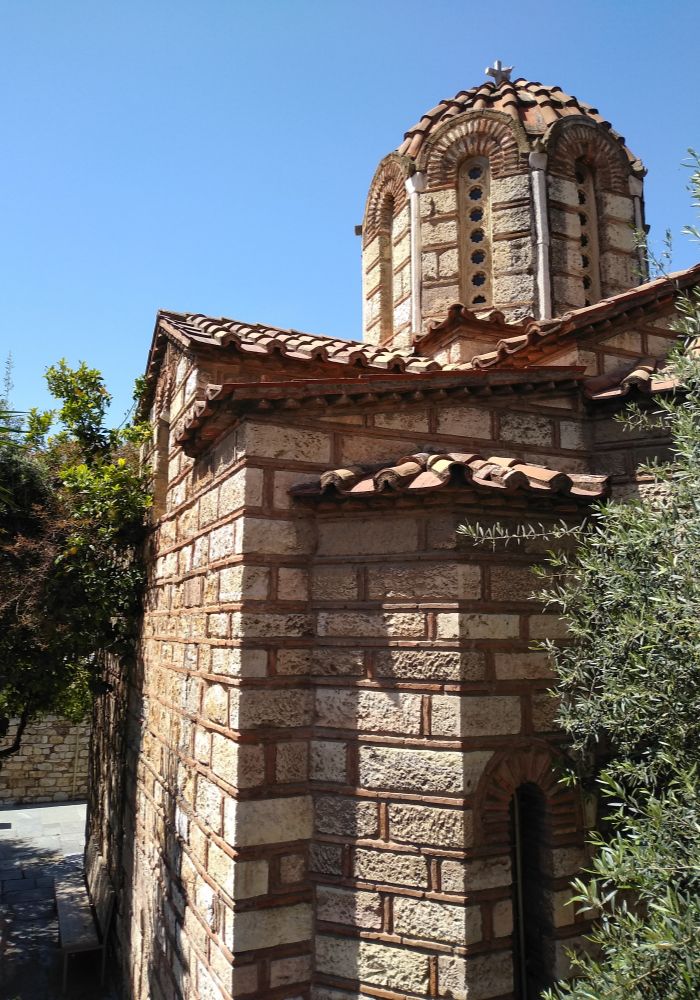
It features a notably graceful Athenian dome and can be found a few meters away from the Thissio metro station, the walkway leading to the Acropolis, the Ancient Agora, and the Jewish Synagogues Synagogues.
It is celebrated on 7 November. Opening hours: 07:00 -12:00. Closed on Thurs. & Sun. afternoons.
6. Agios Nikolaos Ragavas in Plaka
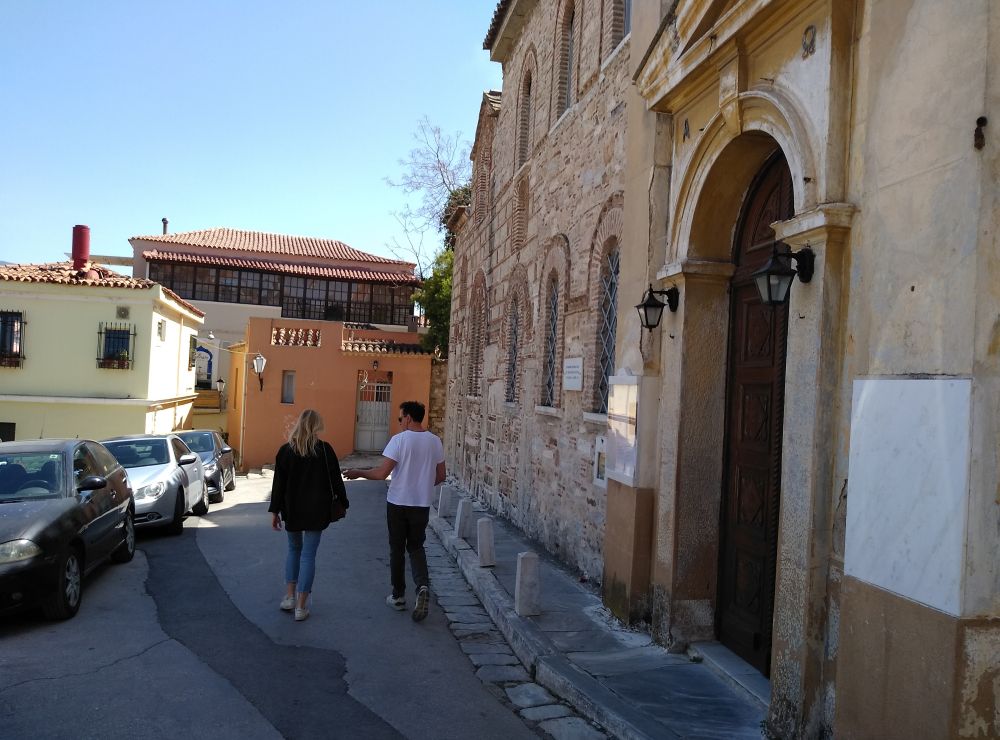
The large church of Agios Nikolaos Ragavas is at the Acropolis hill slope right in the heart of Plaka, Athens’ old town.
It was built in the first half of the 11th century, on top of an ancient Greek Temple with a remaining Ionic column incorporated into its north side.
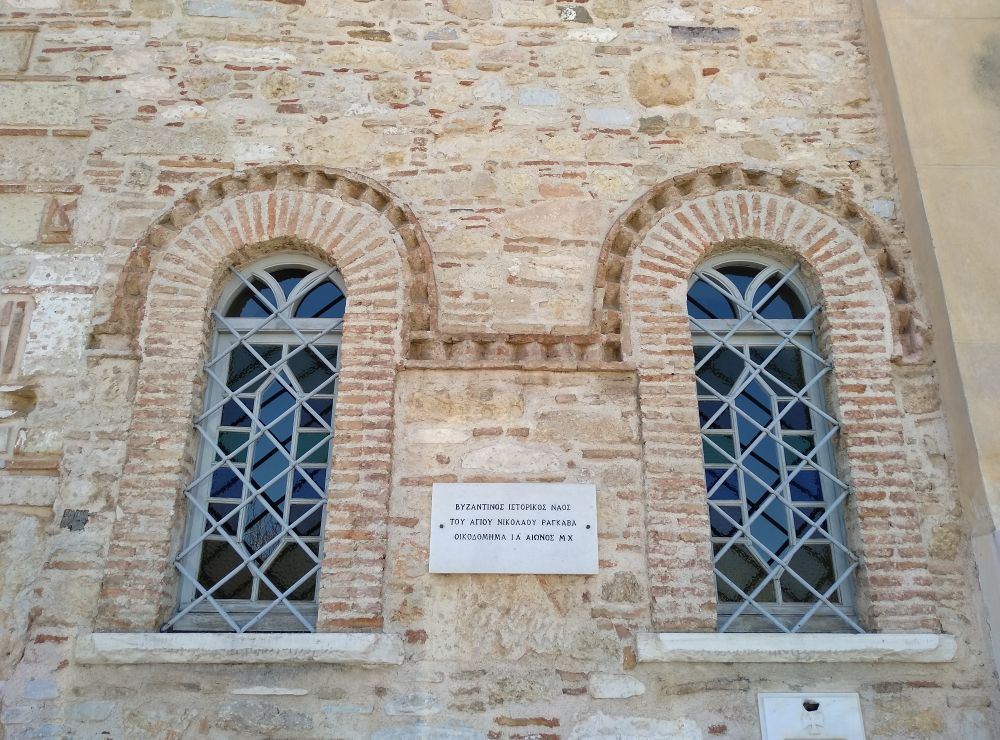
It is part of a complex belonging to the monastery of the Holy Sepulchre in Jerusalem and a very important Athens Byzantine Church.

The holy altar is supported by an inverted Corinthian column, a rather unique use of the ancient column. The Ragavas Byzantine church is a simple four-column cross-inscribed church and it was the first church in Athens to receive its bell after the War of Independence in 1821 (the Ottomans had banned the bells from the Greek churches).
It is celebrated on 6 December.
Entrance Info:
- Opening hours: weekdays 09:00:12:30, Saturday & Sunday 09:00:12:30
- Entrance Fee: Free
- Dress Code: Avoid shorts, remove your hat inside the church
- No food/drinks are allowed besides water
- No photos at all
- Lower your voice
7. Agios Dimitrios Loubardiaris in Acropolis
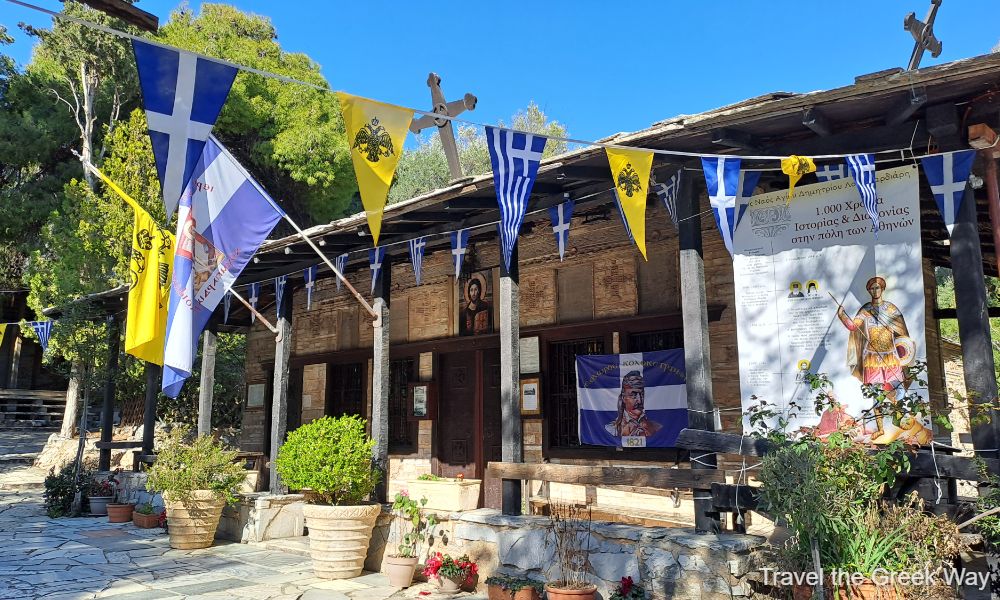
The Byzantine church of Agios Dimitrios Loubardiaris is right across from the Acropolis entrance, on the forested hill of Philopappos. The Basilica was built in the 12th century and its frescoes date back to 1732.
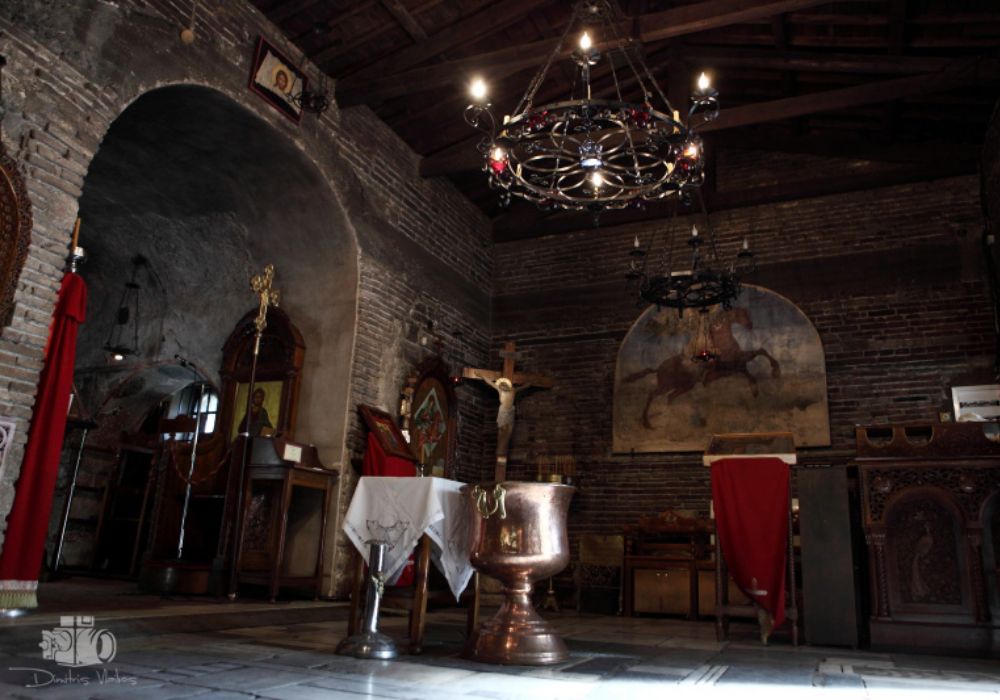
Loubardiaris church is very popular for christenings and as it is at the beginning of the Philopappos forested area, is frequently visited by families, runners, and hikers.
It is celebrated on 16 October.
Entrance Info:
- Opening hours: daily 08:00-12:00, Fri. 08:00-12:00, and 22:00-00:30
- Entrance Fee: Free
- Dress Code: Avoid shorts, remove your hat inside the church
- No food/drinks are allowed besides water
- No photos at all
- Lower your voice
Are you looking for high-quality accommodation near the Acropolis of Athens? Check out the best Acropolis View hotels in Athens!
8. Moni Petraki in Kolonaki
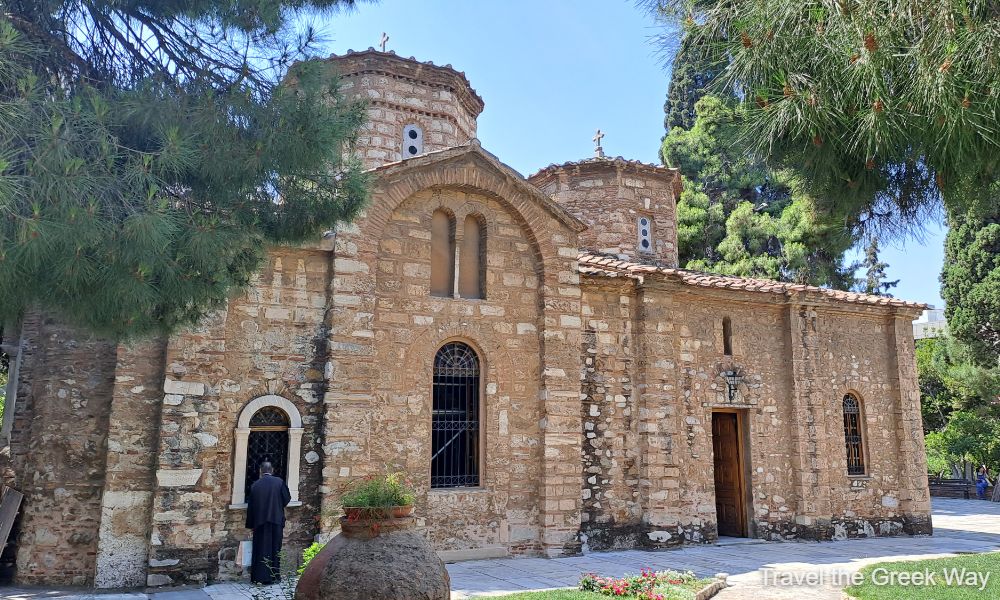
Kolonaki is a central, posh area of Athens full of upscale restaurants and expensive shops. It also houses a few architectural masterpieces like the Benaki Museum and the Catholicon of the Asomatoi Taxiarches Monastery or Moni Petraki.
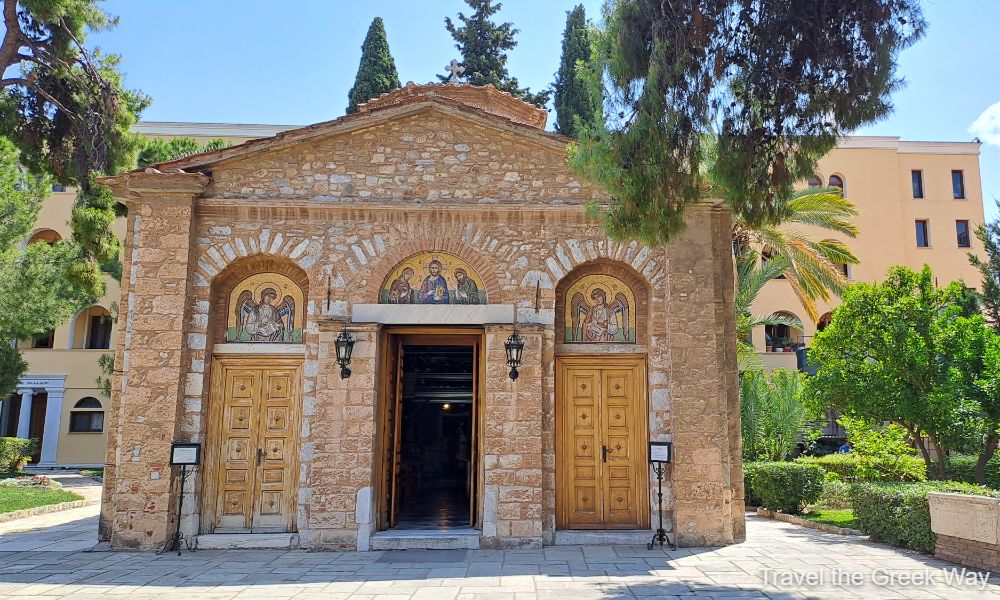
Moni Petraki was constructed in the 10th century CE with Corinthian-type columns and along with Metochi in Plaka, it is a popular church for Easter night celebrations. What is remarkable is that Byzantine Petraki Church has been in continuous use since the 10th century AD, until our days with a short period of desolation between 1500 – 1673 AD.
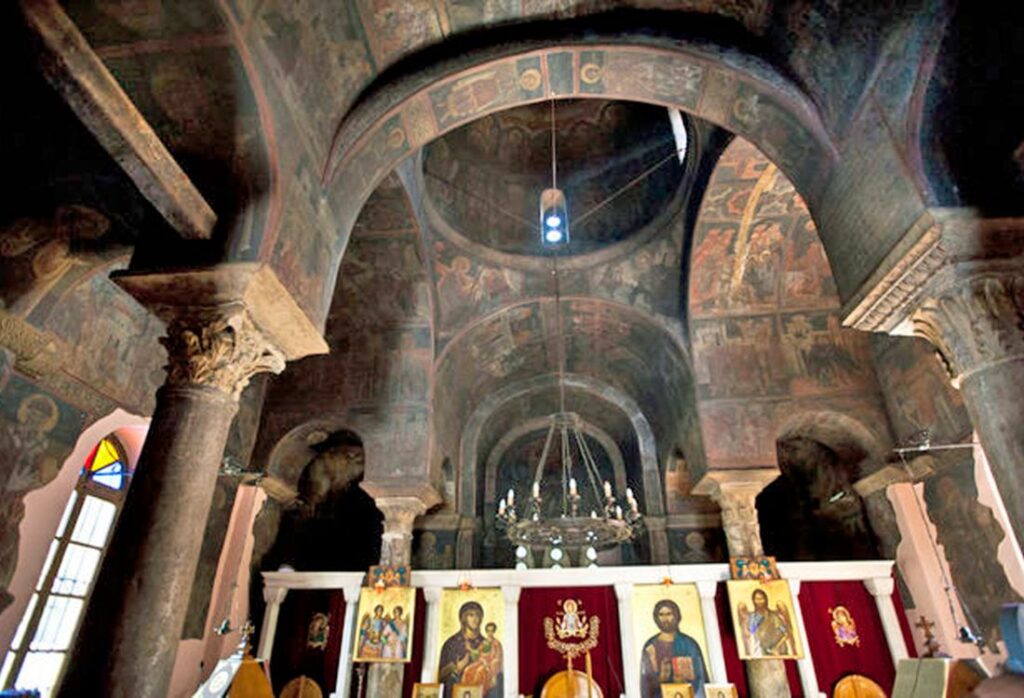
Inside the Catholicon, you can admire the beginning of the domes, the relief cornice, as well as the two small capitals of the two dividing columns of the three-light window. In 1719 A.D. Markos worked on the previous iconography of the Catholicos and managed to remove any Western influence and introduce again the orthodox artwork.
Moni Petraki is celebrated on November 8th. It is daily open Mon-Sun, 06.00-14.00, 17.00-21.30.
9. Monastery of Kesariani
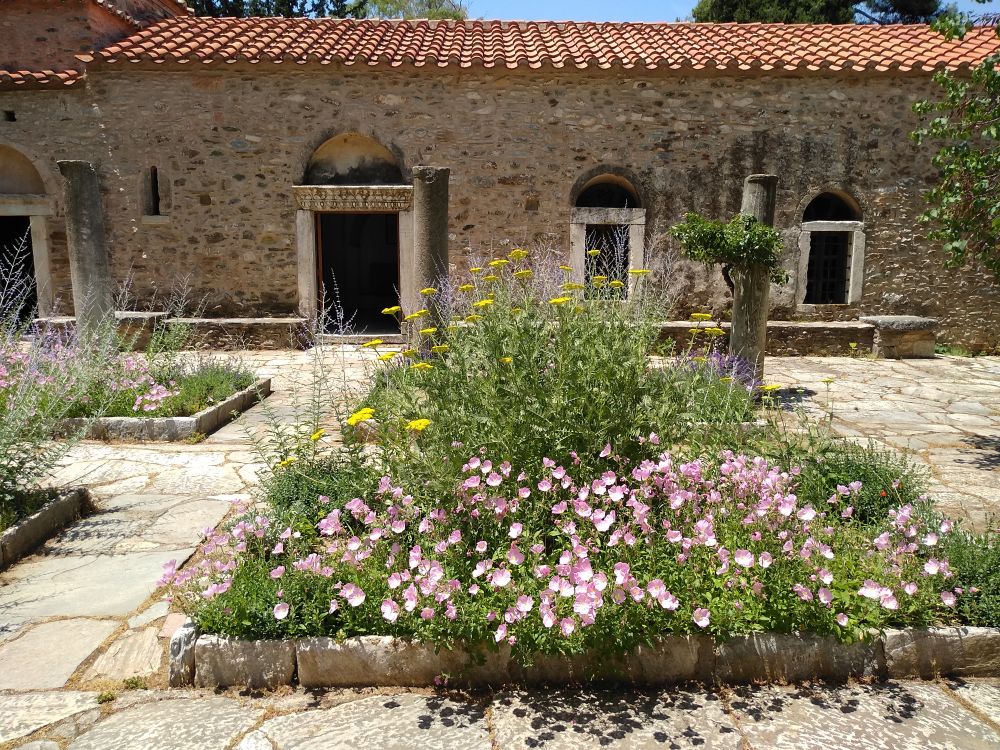
The monastery of Kesariani is one of the most important Athens Byzantine monuments built in the second half of the 11th century. It is hidden in the green forest of Hymettos Mt, near the shrine of Aphrodite, in a gorgeous natural environment with outstanding views of Athens. The monastery of Kesariani is dedicated to the Presentation of the Virgin Mary and it is a nunnery.
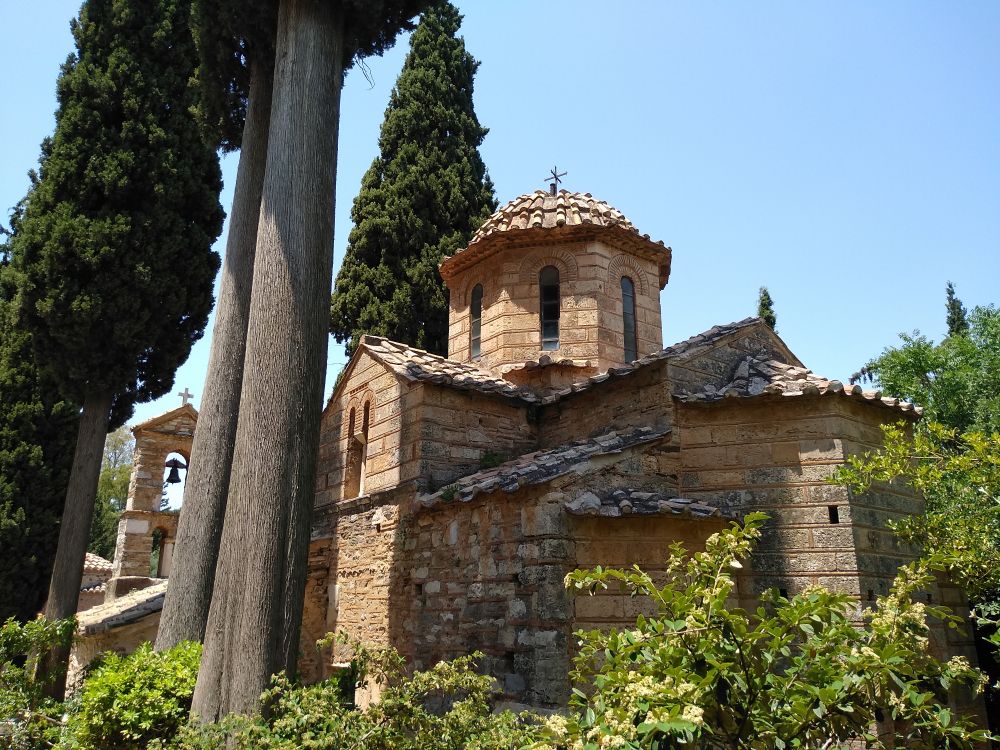
You can visit the Catholicon, the refectory, the kitchen, the nuns’ cells, and look in through the window of the bathhouse. The frescoes of the narthex (painted by John Ypatos according to an in situ inscription) date back to 1682.
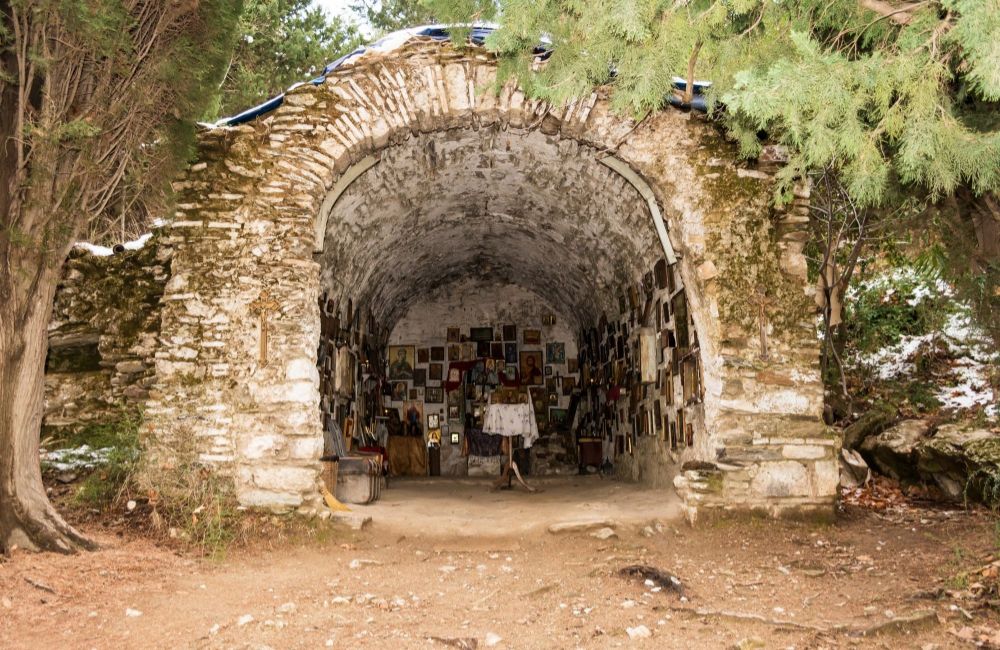
The monastery has a rich library and was also an important center of philosophy. Besides the beautiful medieval complex of the Kesariani monastery, you should visit the botanical walk nearby with the plants’ names written in Latin and English.
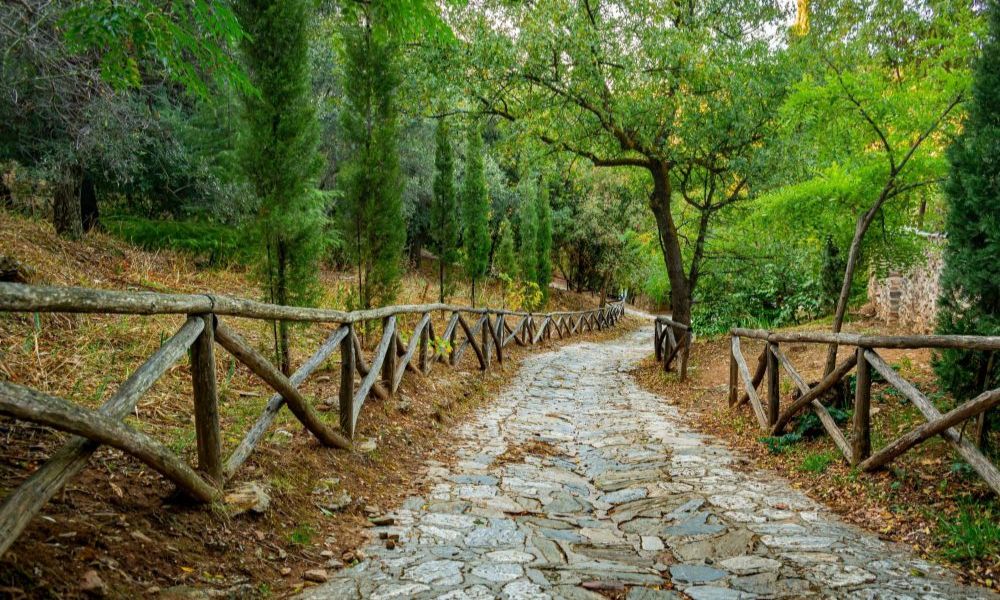
The area is also ideal for hiking, as there are cleared and very well-signposted trails.
Entrance Info:
- Opening hours: daily (except for Tuesdays) between 8.30 am – 16.00 (summer) and 15.00 (winter).
- Entrance Fee: €3
- Dress Code: Avoid shorts, remove your hat inside the church
- No food/drinks are allowed besides water
- Lower your voice
You can go by public bus 224.
10. Daphni Monastery
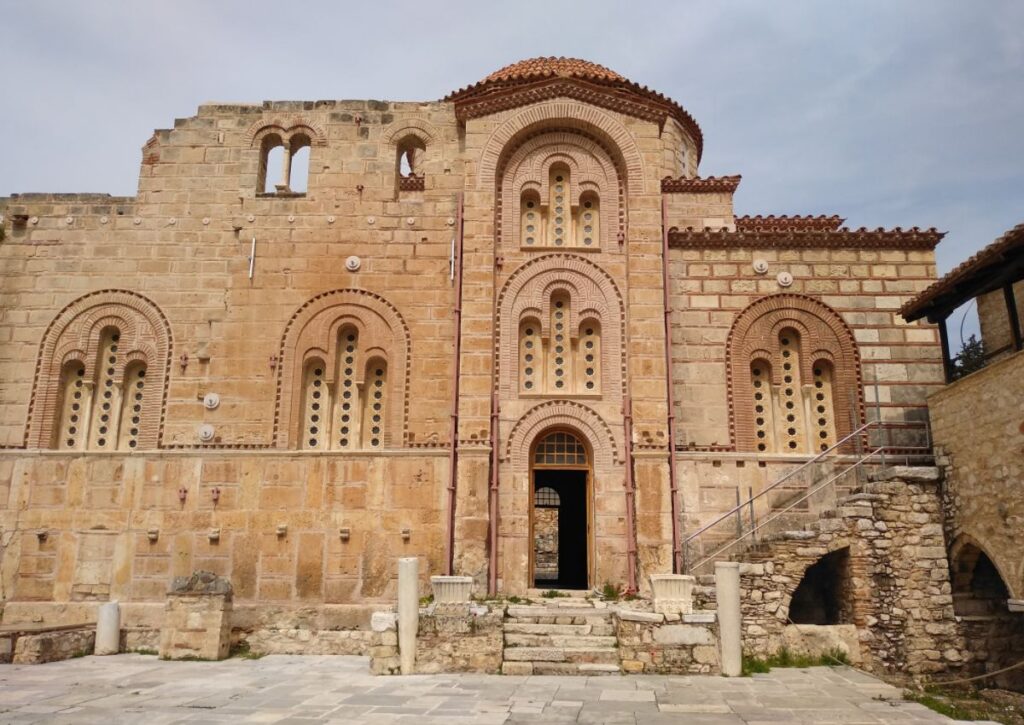
The Byzantine Daphni Monastery, 11 km from Athens center, is a UNESCO world heritage site, that was first built in the 6th century. The Daphni Monastery features unique and impressive mosaics on a gold background, with outstanding artistic characteristics. The Daphni Monastery is often combined with a day tour to Ancient Corinth.
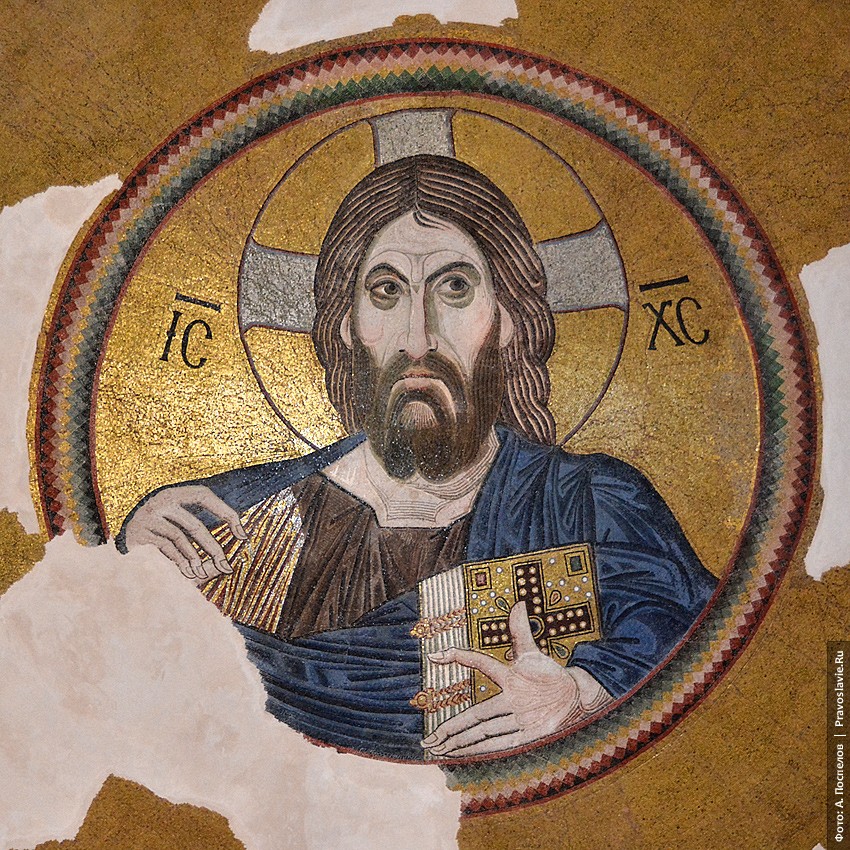
The Monastery also exhibits the architectural perfection of the middle period of Byzantine religious architecture (11th and 12th centuries).
Read my dedicated post on the UNESCO Daphni Monastery in Athens.
Byzantine and Christian Museum
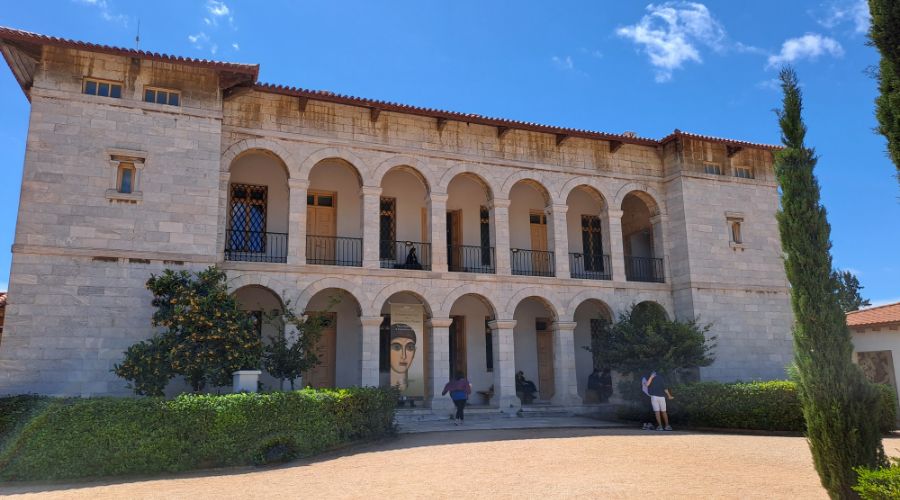
The 11th and 12th centuries are considered the golden ages of Athenian Byzantine art, many of which can be seen at the exceptional Byzantine and Christian museums.
The museum is housed in the beautiful Villa Ilissia and features a wide collection of sculptures, paintings, and other artifacts from the 3rd century AD to medieval times. It also features a fantastic garden cafe, perfect for a break after a warm day. Next door is the newly excavated Archaeological Site of the Lyceum of Aristotle.
Athens Byzantine Churches Map
Get your Google Interactive Map of Athens Churches here to walk to the mentioned churches. The only ones that need a car are the Kesariani and Daphni Monasteries.
Athens Quick Reference
Unesco Monuments in Greece
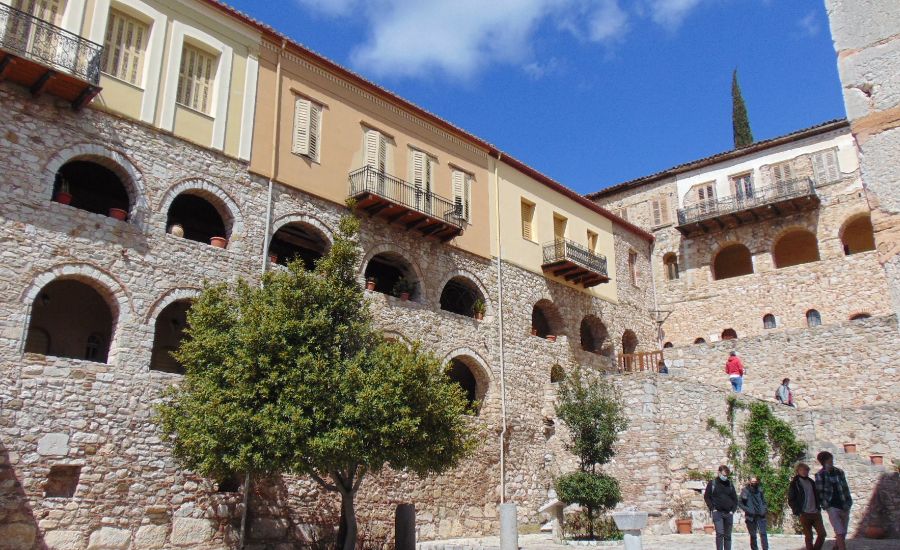
There are the UNESCO Monuments in Greece:
Athens, Attika: Acropolis Hill
Monasteries:
- Daphni in Athens
- Nea Moni in Chios
- Οsios Loukas in Fokida
Northern Greece:
- Vergina
- Philippi
- Paleochristian, and Byzantine Monuments of Thessaloniki
- Mount Athos
- Zagori region (Monodendri)
Peloponnese:
- Mystras
- Olympia
- Apollo Epicurius at Bassae
- Mycenae, and Tiryns
- Sanctuary of Asklepios in Epidaurus
Islands :
- Delos
- Medieval City of Rhodes
- Old Town of Corfu
- Pythagoreion and Heraion of Samos
- The Monastery of Saint-John the Theologian and the Cave of the Apocalypse on Patmos
Central Greece:
Dress Code for Greek Monasteries

Greek Monasteries and the nuns, monks, and priests that keep the tradition alive and running, are requesting the visiting guests to wear modest clothes and behavior inside the Monasteries.
Some ideas about what to wear inside the Monasteries are:
- A Waisted Maxi Dress, perfect for everyday use
- A beautiful shawl to cover your shoulders
- A Nautica Women’s Boatneck Cotton Shirt
Did you visit the Byzantine Churches of Athens? Let me know what you think about visiting the Greek Orthodox Churches in the comments, I’d love to hear whether I managed to get it onto your bucket list! Till next time, Evgenia❤️
Plan My Trip to Greece
Do you need a custom travel itinerary or a transfer within Greece? Are you traveling solo, with your family or friends and need a tailor-made multi-day tour or a transfer?
If yes, please visit my dedicated Plan My Trip Page for a free itinerary!
My Most Popular Posts
- Greece Packing List – What to pack for a 10-day trip to Greece
- First Time to Greece – Most Important FAQ
- Mamma Mia Greece Locations – All the mainland and island shooting areas in Greece
- Athens Hotels Near Acropolis
- Athens Apartments Near Acropolis
- Best Athens Beach Hotels
Essential Travel Resources for Greece
- ‘Hello’ and ‘Thank You’ in Greek: “Ya sou” and “Efharisto”
- Booking.com: I use Booking.com mostly for Europe. It has over 1 Million properties to choose from, including everything from hotels to apartments and even hostels. And free cancellation!
- Expedia: I use Expedia for the best hotel descriptions and amenities and a rewards points system for the rest of the world.
- All-Inclusive Resorts in Greece
- FerryScanner to book ferries to the Greek Islands
- Rent an Affordable Car in Greece
- Athens Metro Website (timetables and ticket info)
- Map of Athens Metro
- Trains (Hellenic Train)
- Public Buses KTEL
- Get Your Guide: For all your day or multi-day tours and city guide needs, I use Get Your Guide
- Emergency Numbers Anywhere in Greece: AMBULANCE 166 – FIRE 199 – POLICE 100– EMERGENCY NUMBER 112
Related post:

